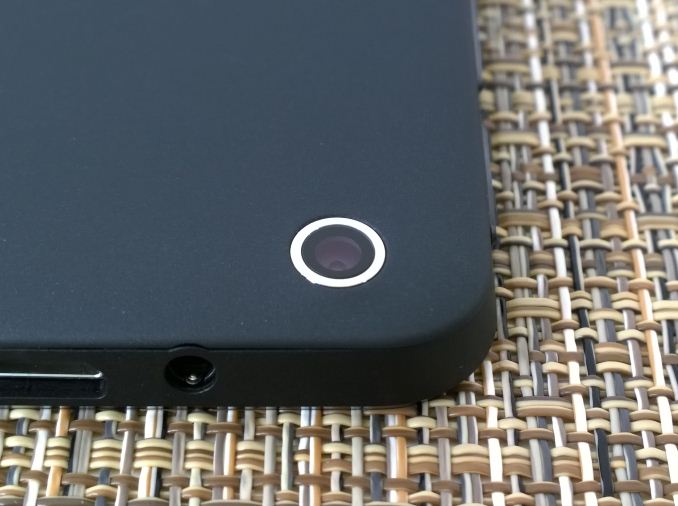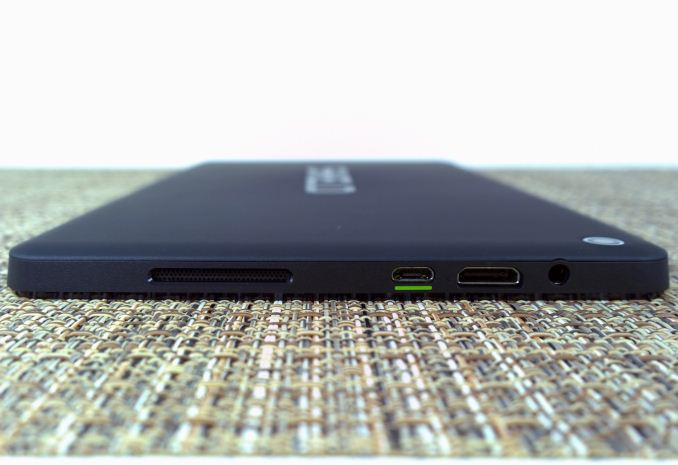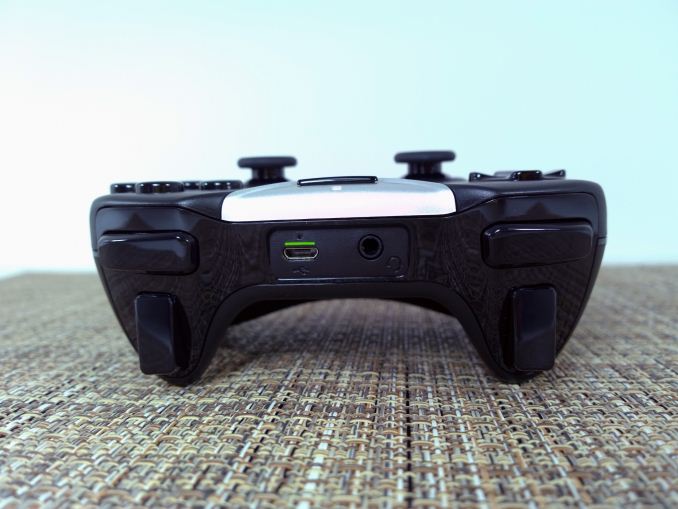The NVIDIA SHIELD Tablet Review
by Joshua Ho on July 29, 2014 9:00 AM ESTFinal Words
If I’m honest, it’s hard for me to review tablets. While I academically understand why people like tablets, I’ve never really found a use for them. They’re less comfortable to use in bed than a phone, I usually can’t type on a tablet as quickly as I do on a phone due to the size and weight, and in general it’s hard to justify a tablet when a phone is generally much more versatile. So when I got the Shield Tablet, I didn’t really know what to expect. While I have a Shield Portable, I don’t spend much time gaming on it, especially when I have a desktop that can do it much better. I came away from my experience pleasantly surprised.
Over the past five days, I’ve learned a lot about this device. As a tablet, it’s good. The material design and industrial design is acceptable and the device itself is quite ergonomic but it doesn’t blow me away. However, given the need to meet cost constraints, the matte plastic feel is really all that’s necessary and I don’t have any complaints in this area.
In the other fundamentals, we see a bit of a checkered pattern. In the display, the static contrast is quite high, and the calibration is good, but the gamut of the display doesn’t cover sRGB. This would definitely be an area that should be improved for the next generation. Although there are some compelling reasons to go with smaller color gamut, it ends up as a disadvantage when compared to other general-purpose tablets. The display is still perfectly usable, but it's a bit more washed out than I'd like.
In battery life, we see that the Shield Tablet ends up doing relatively well in web browsing, but for intensive gaming the tablet can’t spend much time away from an outlet before draining the battery completely. This is likely to be an unavoidable tradeoff, given the immense amounts of performance that Tegra K1 provides versus the power costs of doing so on a 28nm process. Anyone that has lived with a gaming laptop should understand this. As said before, it’s also possible to improve battery life from the 2.5 hour figure if the game is light enough to allow the GPU to run at lower frequencies. Barring that, NVIDIA has included options to cap the maximum frame rate of the display and reduce maximum CPU frequencies.
Otherwise the only other notable difficulty I’ve run into is with the stylus. Generally speaking it works well enough, but the stylus requires a bit more lift between words than I’m used to and keeping it from feeling fully natural. But I will be the first to admit that this is a minor issue at best.
Outside of the tablet itself, the gaming features are compelling. The larger 8” display and massively improved SoC on the Shield Tablet made for a far better gaming experience than what I had on Shield Portable. There’s a great deal of potential in ShadowPlay on a tablet, as while screen recording is nothing new in PCs this feature is often difficult to enable on Android. This is before we talk about the effects that live video encoding has on UI performance. ShadowPlay has managed to enable easy screen recording on a mobile device and do so without significantly impacting performance.
Meanwhile GameStream and GRID are even better on the larger screen that the tablet provides. While it was cool to play PC games on the Shield Portable, the size of the display simply made some elements too small to reasonably see. Now, there are no such issues. GameStream and GRID are definitely a lot of fun to use, especially if the game is well-adapted to playing on a controller.
Ultimately though, I feel that the native game library is the most important aspect of this device. While there are plenty of solid single player games, multiplayer games are few and far between. I still feel that multiplayer is where Shield has the strongest potential because it makes the difference between tens of hours per game and hundreds, even thousands of hours per game. There are definitely signs that this aspect of the ecosystem will improve in the near future as Trine 2 supports local multiplayer and War Thunder on Shield Tablet should be able to play online against console and PC players.
After getting through all of these observations over the past five days, I’ve come to realize that even though it’s not the perfect tablet, all of the features that this device brings to the table right now would be enough for me to seriously consider buying one. If NVIDIA manages to get enough multiplayer titles with an active community on Shield Tablet, there wouldn’t be a need to stop and consider at all. As someone that has spent the past few years never considering a tablet purchase at all, the Shield Tablet is the first ARM tablet that I would seriously think about buying.
The SHIELD Tablet is 299 USD for the 16GB WiFi model, 399 USD for the 32 GB LTE model. Each controller is 59.99 USD and the cover is 39.99 USD. While the 16GB model is 70 dollars more expensive than the Nexus 7 equivalent, the gap narrows to 50 dollars for the 32GB LTE model. Given the sheer amount of utility that this device brings to the table, the pricing is definitely set at the right place.














174 Comments
View All Comments
Wolfpup - Tuesday, July 29, 2014 - link
Wish it had a larger screen. I'd really love a 12" screen for graphic novels and magazines, but I at least want 10".Regarding Half-Life...it's awesome it runs on this, but super lame it I guess REQUIRES Nvidia hardware to run? Android's already a big enough mess as it is. I don't need programs that only run on some and not all Android devices.
Wolfpup - Tuesday, July 29, 2014 - link
I wonder about the controller too...it seems very nice, but wondering if it'll work with PC games or iOS for that matter.vision33r - Tuesday, July 29, 2014 - link
Those of us that owned the 1st gen Shield love it because of the portability and form factor. I am able to use it on the train or plane easily like a NDS. This thing now requires that I put it on the dock or stand.I think they would be better off releasing a Shield with 5.7" display edge to edge instead of the big border.
I can play most games like Skyrim on a 5" display well just annoyed by the border.
chizow - Tuesday, July 29, 2014 - link
If you listen to the MaxPC webcast with Tom Petersen, I think there is a very good chance we see an updated Shield Portable 2. Not sure about a bigger screen, I'd get one too if it had a 6" 1080p screen and TK1, but there's a good chance it has its SoC updated. I am 99% sure Nvidia said TK1 is pin compatible with T4, so it would be an easy upgrade.TheJian - Wednesday, July 30, 2014 - link
Agreed, shield r2 is coming. They have said recently they serve different markets (and they do). There was no mention of it not being revved yearly and specs are out for 4GB, 1440x810 etc. That is no where near this device and seems likely a perfect update to Shield 1 and more geared towards handheld hardcore gamers. Shield was only 10mil to develop, so plopping in K1 shouldn't be much more if they stick with the same design etc, just amp a few things up (memory etc). No need for a massive redesign it was already good. Sticking with 720p or just above should save on power also, again more in line with a handheld usage playing games. MHL 3.0, usb 3.0 and support for a large SD card is all I'd need to jump I think.They said K1 32 and 64 Denver K1 is pin compatible, but not T4. But that's not a huge redesign considering the whole thing only cost 10mil the first time. They only needed to sell about 100K-150K to break even probably (assuming $100 or so profits for each sold based on ~160 vita cost, and 101 for 3ds BOM at launch for them). Everything from Vita/3ds got shrunk so costs are probably similar.
GC2:CS - Tuesday, July 29, 2014 - link
When nvidia had showed its prototype Kepler mobile GPU for the first time for examination here on anadtech I was excited as it showed it was drastically more efficient and faster than the king of mobile GPU's at that time the A6X. It just kind of blew it away, even though Apple really gone wild when talking about SoC's: a custom CPU architecture, a GiGantic GPU, huge amounts of bandwidth etc. But with such Kepler GPU they could afford to wait for a year and still beat everyone at least in theory.But in reality ? A year after Kepler prototype, we have well.... two tablets and an all in one ? And after a year even the power and performance story doesn't look as good as interpreted by nvidia.
After a year we got the new Apple A7 that nVidia claimed about that their new K1 is 3x faster and 50 % more efficient.
Lets compare them now.
A7 gets 13 fps in manhattan and K1 over 30 fps, but still well short of 3x which is.13by3...wait...... about 39 fps. So about 2,4 times faster in comparison, still nice.
Then there is efficiency. Running down a 19.75 battery in 2.2 hours with a display that consumes AT MOST 1,46 W at 200 nits yields an power consumption of all other components of AT LEAST 7,3W (most of that is the SoC+RAM) which is downright ridiculous. Then there is throttling. Maybe it doesn't look significant on that chart, but it reached vsync in first dozen runs. Taking into consideration off screen tests, without vsync it would run at about 63,5 at native resolution and it would start throttling sooner. Now going down to 46,1 thats a difference of 27%. Still nice for so many runs, but not all tablets have dedicated magnesium heat spreader installed in them and I don't think it will be problem for a gamer to play a PC game port for 70 minutes or more non-stop. But the bad thing is that it throttles even with that heat spreader, and that means its really hot.
And now lets compare with A7. Its got far far lower power compustion under full load and also generates far less heat, so it the GPU doesn't throttle at all. Taking this into consideration, the tegra can be less than 2,4 x the A7, especially in tablets without custom heat spreaders and after prolonged use. And ouch a phone ! You can put the A7 into a phone ! And the GPU doesn't throttle at all as well. And then the A7 is 10 months old chip and still tegra has a hard time even in terms of efficiency. The A8 will be entirely different league, it will crush tegra, not it performance, but in efficiency.
Considering all of this it just kind of dissapoints me.
identity - Tuesday, July 29, 2014 - link
iSheep trying to spread that Apple propaganda lol! Nice try though :)melgross - Tuesday, July 29, 2014 - link
The fact that you feel the need to use that word just shows that your thinking is very limited. If you have something useful to say, try to refute what he said instead. Stop acting as though you're 12 years old.ams23 - Tuesday, July 29, 2014 - link
Mobile Kepler in Tegra K1 is roughly 50% more power efficient than G6430 in A7 with GFXBench 3.0 Manhattan Offscreen test: http://images.anandtech.com/doci/7622/Screen%20Sho...Regarding throttling, there is virtually no throttling on Shield tablet until after 115 (!) runs: http://images.anandtech.com/doci/8296/TRexRunDownG... . You can see that Onscreen fps only varies by a couple fps during that time.
As for battery life, Shield tablet has a battery saver mode which should result in superior battery life for gaming.
At the end of the day, mobile Kepler can reach performance levels and playable settings that other thin fanless tablets currently on the market cannot even hope to reach. I would much rather have 3 hours of smooth and playable gameplay at 30-60fps than 5 hours of non-playable gameplay at 15-25fps.
melgross - Tuesday, July 29, 2014 - link
That's very true. But this is a new chip, and the A7 is now becoming an old chip, by the standards of mobile development. It will be interesting to see whether Apple can improve the A8 by the amounts they've been doing the past generations. Rumor has it that it will again be a 2 core design. If so, it could lead to some interesting strategies on the part of Apple.But, like anything else, we'll have to wait.